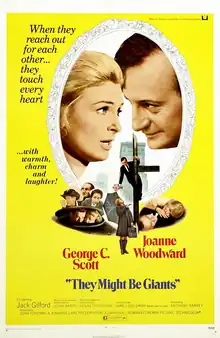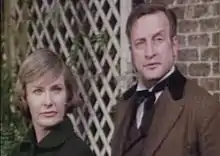| They Might Be Giants | |
|---|---|
 Theatrical release poster | |
| Directed by | Anthony Harvey |
| Screenplay by | James Goldman |
| Based on | They Might Be Giants 1961 play by James Goldman |
| Produced by | John Foreman |
| Starring | George C. Scott Joanne Woodward Jack Gilford Lester Rawlins Al Lewis Rue McClanahan |
| Cinematography | Victor J. Kemper |
| Edited by | Gerald B. Greenberg |
| Music by | John Barry |
Production company | Newman-Foreman Company |
| Distributed by | Universal Pictures |
Release date |
|
Running time | 98 minutes |
| Country | United States |
| Language | English |
They Might Be Giants is a 1971 American comedy mystery film based on the 1961 play of the same name (both written by James Goldman) starring George C. Scott and Joanne Woodward. The play opened at Stratford East in 1961, and closed after only four weeks.[1]
The film's title was later adopted as the name of a popular music group.[2]
Plot

Justin Playfair (Scott) is a judge who retreats into fantasy after his wife's death, imagining himself to be Sherlock Holmes, the legendary fictional detective. Complete with deerstalker hat, pipe and violin, he spends his days in a homemade criminal laboratory obsessing over plots hatched by his (Holmes's) archenemy, Professor Moriarty.
When his brother (Lester Rawlins) tries to place Justin under observation in a mental institution so he can get power of attorney, Justin attracts the attention of Dr. Mildred Watson (Woodward), a psychiatrist who becomes fascinated by his case. Justin demonstrates to her a knack for what Holmes describes as "deduction" (technically better categorized as abductive reasoning) and walks out of the institution during the ensuing confusion. Intrigued, Watson comes to his home to attempt treatment. Playfair is initially dismissive of Watson's attempts to psychoanalyze him and he analyzes her instead, but when he hears her name, he enthusiastically incorporates her into his life as Doctor Watson, the sidekick to his Holmes.
The duo begin an enigmatic quest for Moriarty, with Playfair/Holmes following all manner of bizarre and (to Watson) unintelligible clues, and encountering a rich tapestry of eccentric people in assorted urban situations, the two growing closer to each other in the process.
Eventually Watson invites Holmes over for dinner, but in preparation for this she becomes extremely nervous and distraught, apparently recognizing that they may be becoming romantically intimate. Strangely she is wearing a wedding gown for this very basic dinner in a small apartment. The two then head out on a kind of odyssey where they revisit each of the weird people that they’ve met, who then join up with them in a kind of triumphal parade, with Watson wearing her bridal gown.
But somehow the minor characters melt away, and we are left with Holmes and Watson in a park, where they stand together in front of the underpass of a bridge, as if before an altar. They look on expectantly and a bright light shines, but the light resembles that of a police car or even a subway train more than a divine illumination.
Cast
- George C. Scott as Justin
- Joanne Woodward as Watson
- Jack Gilford as Peabody
- Lester Rawlins as Blevins
- Al Lewis as Messenger
- Rue McClanahan as Daisy
- Ron Weyand as Dr. Strauss
- Oliver Clark as Mr. Small
- Theresa Merritt as Peggy
- Michael McGuire as Telephone Guard
- Eugene Roche as Policeman
- James Tolkan as Mr. Brown
- Kitty Winn as Grace
- Sudie Bond as Maud
- Staats Cotsworth as Winthrop
- F. Murray Abraham as Clyde
- Paul Benedict as Chestnut Man
- M. Emmet Walsh as 1st Sanitation Man
- Louis Zorich as 2nd Sanitation Man
Title explanation
The title is an indirect reference to Don Quixote's famous exploit of tilting at windmills, believing them to be "monstrous giants". In reference to this, the character Playfair argues:
Well he had a point. Of course, he carried it a bit too far. He thought that every windmill was a giant. That's insane. But, thinking that they might be...well...all the best minds used to think the world was flat. — But, what if it isn't? — It might be round — and bread mold might be medicine. If we never looked at things and thought of what they might be, why, we'd all still be out there in the tall grass with the apes.[3]
Critical views
The film opened to mixed reviews. Vincent Canby of The New York Times called it "a mushy movie with occasional, isolated moments of legitimate comedy."[4] On Rotten Tomatoes it has an approval rating 61% based on reviews from 18 critics.[5]
Releases
There have been various running times of the film over the years with the Kino Blu-ray at 91 minutes. The largest missing material is a long sequence near the end that takes place in a grocery store.[6]
References
- ↑ Barnes, Alan (2011). Sherlock Holmes on Screen. Titan Books. p. 288. ISBN 9780857687760.
- ↑ Walker, Chloe (June 9, 2021). "They Might Be Giants Remains as Charmingly Weird as the Band Its Name Inspired". Paste. Retrieved December 31, 2023.
- ↑ Howell, Cory (February 14, 2014). "Review: They Might Be Giants". I Hear of Sherlock Everywhere. Retrieved December 31, 2023.
- ↑ Canby, Vincent (June 10, 1971). "They Might Be Giants". The New York Times.
- ↑ "They Might be Giants". Rotten Tomatoes.
- ↑ Galbraith IV, Stuart (June 11, 2019). "They Might Be Giants". DVD Talk. Retrieved December 31, 2023.